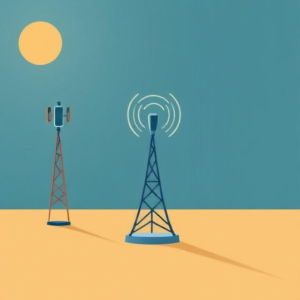What is Code Division Multiplexing (CDM)?
Code Division Multiplexing (CDM) is a technique used to allow multiple signals or data streams to share the same transmission channel (like radio waves, wireless networks, or other communication mediums) at the same time. The main idea behind CDM is that each signal is assigned a unique code to distinguish it from other signals.

In simpler terms, CDM lets many different signals use the same space (channel) without interfering with each other by giving each one a unique “identity” (code).
How Does CDM Work?
- Unique Codes for Each Signal:
- Each signal or user is given a unique code (sometimes called a spreading code).
- These codes are designed in such a way that they look random or very different from each other, making it easy to separate them when needed.
- Signals Are Sent Simultaneously:
- All the signals are transmitted at the same time using the same frequency or channel.
- The key difference is that each signal is spread out across the channel using its unique code, so even though they overlap, they don’t interfere with each other.
- Decoding the Signals:
- At the receiving end, the receiver knows the unique codes assigned to each signal.
- It can use the correct code to extract the original signal from the mixed transmission. Think of the code as a key that helps the receiver pick out the right signal from all the signals traveling together.
Simple Example of CDM:
Imagine you have a large group of people at a party, and everyone is talking at once. Normally, if everyone speaks at the same time, the voices would overlap and it would be hard to understand what anyone is saying. But imagine if each person speaks in a different language that only certain people understand. The people who know a particular language can easily understand what’s being said, even though everyone is speaking at the same time.
In this analogy:
- The people are the signals.
- The different languages are the unique codes.
- The listeners who understand certain languages are the receivers with the correct code to decode the signal.
Why is CDM Useful?
- Efficient Use of Resources:
- CDM allows multiple signals to be sent at once without needing extra channels or frequencies. This is especially useful in crowded systems where there is limited bandwidth (like in cellular networks).
- Security and Privacy:
- Since each signal is encoded with a unique code, it becomes difficult for unauthorized users to intercept and understand the signal without the correct code. This adds a layer of security to communications.
- Resistance to Interference:
- CDM systems are more resistant to interference because even if some signals overlap, as long as the codes are strong enough, the receiver can still extract the correct data.
Real-World Example of CDM:
The most famous example of Code Division Multiplexing (CDM) is the CDMA (Code Division Multiple Access) used in cellular networks (like in 2G and 3G networks).
- CDMA in Cell Phones: In a busy area, many people might be making calls on the same frequency (the same channel). With CDMA, each phone call is encoded with a unique code. All the calls are sent at once, and each phone on the network can pick out its own call from the mix based on its unique code. Even though everyone is using the same frequency, the calls don’t interfere with each other.
How is CDM Different from Other Multiplexing Techniques?
- Time Division Multiplexing (TDM): In TDM, each signal takes turns using the same channel by getting its own time slot. In CDM, all signals share the same time and space but use different codes to avoid interference.
- Frequency Division Multiplexing (FDM): In FDM, different signals are assigned different frequency bands, and they send data at the same time. In CDM, signals share the same frequency, but each one is distinguished by a unique code.
Summary:
- Code Division Multiplexing (CDM) allows multiple signals to be sent at the same time over the same channel by giving each signal a unique code.
- The signals are spread out using their unique codes, and the receiver uses the correct code to pick out and decode the right signal.
- CDM is widely used in cellular networks (like CDMA) and wireless communication because it makes efficient use of the available bandwidth, adds security, and helps prevent interference.











